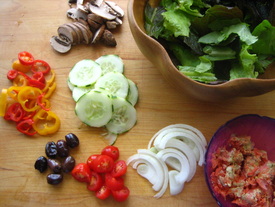 Frequently eating foods prepared away from home is associated with obesity, higher body fat and a higher BMI. It makes sense, doesn't it? Restaurant owners don’t’ care about your pant size or blood pressure, they just want their food to taste delicious and ensure you come back for more. It’s all about that salt, sugar, and fat. Ahh the brain orgasm, or what Michael Moss calls the “bliss point” in his great book. When you cook at home, it’s your hand that’s shaking that salt shaker, putting oil in the pan before you sauté, or sprinkling in that bit of sugar to cut the tartness of your dish. When you cook at home, you control the calories and the flavor. So why don’t we do it more often? Some studies show that the lack of cooking knowledge, confidence, and skills can limit at-home meal preparation. Others explicate our lack of time. Another theory is the drudgery of cooking as many people cook alone, which is a historical exception. Currently we spend an average of 55 minutes per day preparing meals (prepping, cooking, cleaning), down almost 50% since 1965. All the while, most Americans spend up to 5 hours watching TV each day. As Michael Pollan suggests, cooking has become a spectator sport with many of us spending more time watching the Food Network than standing behind our cutting boards. Pollan's new books Cooked by the way is amazing - what a revelation to think that cooking, not nutrient or calorie intake, can quash the epidemic of preventable chronic disease we face. So how do we get folks back into the kitchen? Or at least spending more time cooking meals from scratch rather than relying heavily on packaged and convenience foods (e.g., boxed flavored rice, pasta sauce jars, frozen pizzas), which are faster to prepare yet higher in fat, calories, salt and sugar? PLAN AHEAD. Simplify mealtime by prepping as much as possible ahead of time:
KEEP IT SIMPLE. Go to your local library and pick up a few simple, user-friendly cookbooks. Some quick go-to meals include:
STOCK YOUR KITCHEN: Healthy cooking starts with filling your cupboards. Keep these basics on hand, and you'll be able to whip up delicious meals in less than the time it takes for pizza to be delivered. Basic healthy cooking tools:
USE THE TACO BELL APPROACH: Learn to recombine a few basic ingredients into multiple tasty dishes. PAPER PLATES? If dirty dishes are tempting you to eat out, use paper plates. While I don’t recommend using them for every meal, less cleanup time is a common barrier these help eliminate. I'll leave you with a cute little video where Michael Pollan explains how cooking can change your life.
0 Comments
Leave a Reply. |
AuthorHello and welcome! My name is Andrea Notch Mayzeles. I am a Certified Health Education Specialist, Mom, and Master of Public Health dedicated to the path of well-being. As a wellness professional I am committed to continued learning and am here to share research, recipes and musings on health, psychology, personal development, and parenting. I hope you enjoy! Categories
All
|

 RSS Feed
RSS Feed